- Joined
- Aug 10, 2018
- Messages
- 953
- Reaction score
- 1,070
Since Easter Sunday, PA has gotten a ton of rain with my hometown of Blairsville checking in at 4.7 inches by Thursday. This caused severe flooding throughout the region and the Ohio river crested at over 28 feet at "The Point" in Pittsburgh (the confluence of the Allegheny and Monongahela rivers where they form the Ohio). It could have been much worse and with Sunday, April 7th being the first sunny day in a week, I decided to neglect the yardwork that was pestering to be done and, instead, enjoy a paddling experience that only presents itself once or twice a year when the Conemaugh dam is closed and the flood waters back up to surround my hometown.
This dam on the Conemaugh is not the earthen structure that devastated Johnstown when if failed in 1889 but, instead, it is one of 16 dams operated by the US Army Corps of Engineers (Pittsburgh District) to prevent flooding and facilitate barge traffic on the Ohio river and its tributaries.
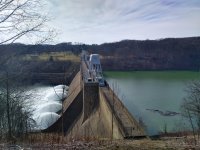
The Conemaugh dam controls drainage from over 1300 square miles and can lower water levels in Pittsburgh by 4 feet. It does this by swelling from its 800 acre normal pool to over 6800 acres at max capacity making it (albeit intermittently) the second largest lake to be wholly contained within the state. (only Lake Raystown is larger)
During the past week, the water level behind the dam increased by 58 feet, filling the reservoir to 74% of its capacity and backing the standing pool up about 3 or 4 miles upstream of Blairsville.
The streets adjacent to the river were closed so I parked on the next street up and portaged 1 block (how many rods are in a block?) to the riverside bike trail which served nicely as a launch ramp.
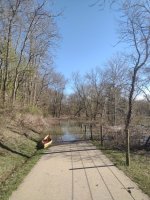
I paddled downstream around the Bairdstown bridge (recently renamed some memorial bridge but I’m a bit old-school I guess). The bridge serves as a gauge locally and most residents can tell you the highest they’d ever seen the water based upon the bridge. In my case, I’d seen it touching the downhill edge of the top rail once but, during this storm, it only got to within 3 or 4 feet of that. Still pretty impressive when compared to the picture of the take-out on our Upper Conemaugh trip last Memorial day. With more rain in the forecast, the Army Corps opened the crest gates for the first time since 2010 and were draining 123,000 gallons of water per second from the reservoir but there was still no noticeable current at the launch.
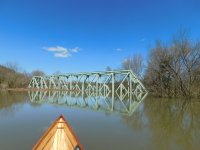
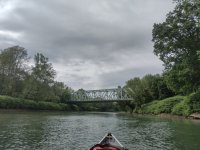
I passed under the route 22 bridge and, as the sounds of traffic faded, it became a very serene paddle through the flooded state game lands.
About a mile below the launch, I came across an inflatable cooler carrier. It must be good quality as it had obviously spent at least one winter in the elements and was still fully inflated. I dumped out the rain water & tied it to the canoe figuring I could do some river cleanup as I paddled.
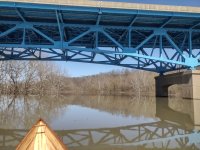
I was, once again, pleasantly surprised by the amount of garbage floating among the woodland detritus and last year’s knotweed stalks. It seemed that much of the human pollution consisted of sports drink bottles and balls. (Somewhere upstream there must be some well hydrated soccer and basketball teams doing fund drives for new equipment.)
This is, however, far better than when I was a kid as I remember couches, refrigerators, tires, etc. floating near the bridges as we drove around looking at the high water (yeah, we did that… small town, only 2 channels on tv and not much else to do… the floods were fascinating to us as kids)
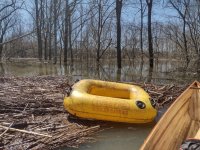
Another mile or so downstream brought me to another Blue Heron nesting site (we had also found one last Memorial Day near New Florence) with nests on both sides of the river and 30-40 birds already nesting. All of the nests were in Sycamore trees which, I suppose, isn’t terribly surprising. First because Herons exhibit a preference for the tree species in which they were born and secondly because Sycamore trees grow well with wet feet and, although there are some maples along the river, the frequent submersion seems to have killed off most of the hardwood species while the Sycamores have thrived.
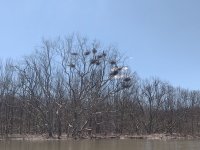
I continued collecting easy to reach garbage for another couple of miles until I passed under a railroad bridge and the reconstructed foot / bike bridge that carries the West Penn Trail across the river to the Westinghouse trailhead. This area, just upstream from where Blacklick creek comes in from the east, is part of the standing pool even at normal water levels and I saw my first people of the trip here. There were 2 men on the West Penn Trail bridge, 1 attempting to fish and the other taking pictures.
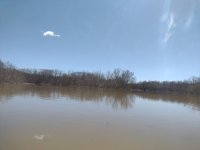
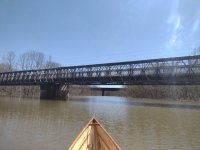
I turned around just below Blacklick creek and started back towing my makeshift garbage scow. As previously mentioned, there was little noticeable current and the raft towed easily but I tucked into and paddled among the submerged trees to cut corners off of the bends and to avoid the headwind that was picking up. The raft, being tied to a seat rail, would track to the side of the canoe rather than directly behind so it was often colliding with trees that I had missed.
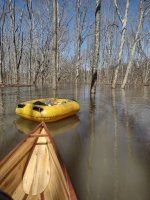
Another problem with taking shortcuts outside of the established channel is that floating debris would collect among the trees and there was not always a clear path. There was only one time that I actually hit a dead end and was forced to backtrack but the novelty of paddling through the trees was sufficient to lure me back among the them at the next opportunity.
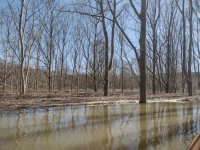
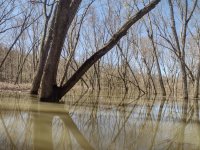
As I paddled back past the Herons, I tried to stay toward the center of the river as there were nests on both sides and I tried to disturb them as little as possible. My presence did not go unnoticed but most of the birds settled for squawking at me and only a few left their nests.
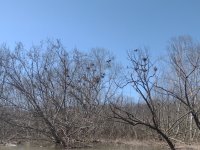
By the time I was nearing Blairsville, the garbage raft was becoming full and sitting lower in the water as it was weighted down by several glass bottles, an old propane cylinder and what I think was a channel marking bouy although I have no idea where it would have come from. Perhaps it once marked one of the power plant dams upstream and the chain securing it had broken but it was actually quite heavy and I was wishing that I’d filled the raft completely on the way downstream.
It would have been easier to have dragged it ashore by the bridges and then driven to the trailhead to retrieve it.
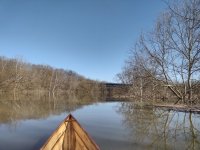
Nonetheless, I passed under the route 22 bridge dragging my prizes and approached the flooded Bairdstown bridge from river left. There was quite the logjam of forest debris piled up on the upstream side so I paddled through the bridge where I met 4 paddleboarders who had launched at Bolivar.
They said that they had encountered standing water just as they exited Packsaddle Gap and that the rapid below Bolivar was huge when they passed through it in the morning.
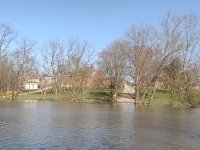
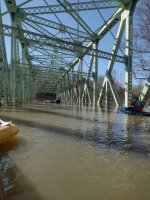
I returned to my improvised launch, emptied the cooler raft into a garbage can there and portaged everything back to my truck.
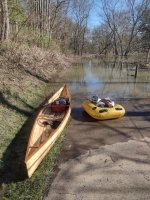
In all, it was great to be back on the water, I do enjoy the novelty of paddling among the flooded trees and it was a beautiful day to do so. I will, however, admit that there were several times during the paddle where I envisioned the final scene from the movie Deliverance so you may not want to be terribly familiar with that movie before you go. Or you could take a bow and a quiver of arrows… either way works but it’s worth a paddle the next time Pittsburgh is being threatened with flooding.
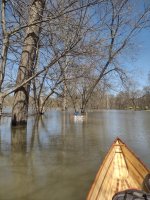
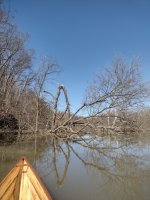
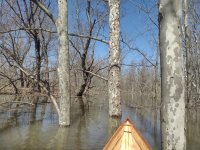
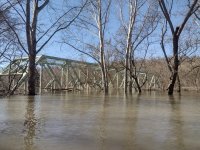
This dam on the Conemaugh is not the earthen structure that devastated Johnstown when if failed in 1889 but, instead, it is one of 16 dams operated by the US Army Corps of Engineers (Pittsburgh District) to prevent flooding and facilitate barge traffic on the Ohio river and its tributaries.

The Conemaugh dam controls drainage from over 1300 square miles and can lower water levels in Pittsburgh by 4 feet. It does this by swelling from its 800 acre normal pool to over 6800 acres at max capacity making it (albeit intermittently) the second largest lake to be wholly contained within the state. (only Lake Raystown is larger)
During the past week, the water level behind the dam increased by 58 feet, filling the reservoir to 74% of its capacity and backing the standing pool up about 3 or 4 miles upstream of Blairsville.
The streets adjacent to the river were closed so I parked on the next street up and portaged 1 block (how many rods are in a block?) to the riverside bike trail which served nicely as a launch ramp.

I paddled downstream around the Bairdstown bridge (recently renamed some memorial bridge but I’m a bit old-school I guess). The bridge serves as a gauge locally and most residents can tell you the highest they’d ever seen the water based upon the bridge. In my case, I’d seen it touching the downhill edge of the top rail once but, during this storm, it only got to within 3 or 4 feet of that. Still pretty impressive when compared to the picture of the take-out on our Upper Conemaugh trip last Memorial day. With more rain in the forecast, the Army Corps opened the crest gates for the first time since 2010 and were draining 123,000 gallons of water per second from the reservoir but there was still no noticeable current at the launch.


I passed under the route 22 bridge and, as the sounds of traffic faded, it became a very serene paddle through the flooded state game lands.
About a mile below the launch, I came across an inflatable cooler carrier. It must be good quality as it had obviously spent at least one winter in the elements and was still fully inflated. I dumped out the rain water & tied it to the canoe figuring I could do some river cleanup as I paddled.

I was, once again, pleasantly surprised by the amount of garbage floating among the woodland detritus and last year’s knotweed stalks. It seemed that much of the human pollution consisted of sports drink bottles and balls. (Somewhere upstream there must be some well hydrated soccer and basketball teams doing fund drives for new equipment.)
This is, however, far better than when I was a kid as I remember couches, refrigerators, tires, etc. floating near the bridges as we drove around looking at the high water (yeah, we did that… small town, only 2 channels on tv and not much else to do… the floods were fascinating to us as kids)

Another mile or so downstream brought me to another Blue Heron nesting site (we had also found one last Memorial Day near New Florence) with nests on both sides of the river and 30-40 birds already nesting. All of the nests were in Sycamore trees which, I suppose, isn’t terribly surprising. First because Herons exhibit a preference for the tree species in which they were born and secondly because Sycamore trees grow well with wet feet and, although there are some maples along the river, the frequent submersion seems to have killed off most of the hardwood species while the Sycamores have thrived.

I continued collecting easy to reach garbage for another couple of miles until I passed under a railroad bridge and the reconstructed foot / bike bridge that carries the West Penn Trail across the river to the Westinghouse trailhead. This area, just upstream from where Blacklick creek comes in from the east, is part of the standing pool even at normal water levels and I saw my first people of the trip here. There were 2 men on the West Penn Trail bridge, 1 attempting to fish and the other taking pictures.


I turned around just below Blacklick creek and started back towing my makeshift garbage scow. As previously mentioned, there was little noticeable current and the raft towed easily but I tucked into and paddled among the submerged trees to cut corners off of the bends and to avoid the headwind that was picking up. The raft, being tied to a seat rail, would track to the side of the canoe rather than directly behind so it was often colliding with trees that I had missed.

Another problem with taking shortcuts outside of the established channel is that floating debris would collect among the trees and there was not always a clear path. There was only one time that I actually hit a dead end and was forced to backtrack but the novelty of paddling through the trees was sufficient to lure me back among the them at the next opportunity.


As I paddled back past the Herons, I tried to stay toward the center of the river as there were nests on both sides and I tried to disturb them as little as possible. My presence did not go unnoticed but most of the birds settled for squawking at me and only a few left their nests.

By the time I was nearing Blairsville, the garbage raft was becoming full and sitting lower in the water as it was weighted down by several glass bottles, an old propane cylinder and what I think was a channel marking bouy although I have no idea where it would have come from. Perhaps it once marked one of the power plant dams upstream and the chain securing it had broken but it was actually quite heavy and I was wishing that I’d filled the raft completely on the way downstream.
It would have been easier to have dragged it ashore by the bridges and then driven to the trailhead to retrieve it.

Nonetheless, I passed under the route 22 bridge dragging my prizes and approached the flooded Bairdstown bridge from river left. There was quite the logjam of forest debris piled up on the upstream side so I paddled through the bridge where I met 4 paddleboarders who had launched at Bolivar.
They said that they had encountered standing water just as they exited Packsaddle Gap and that the rapid below Bolivar was huge when they passed through it in the morning.


I returned to my improvised launch, emptied the cooler raft into a garbage can there and portaged everything back to my truck.

In all, it was great to be back on the water, I do enjoy the novelty of paddling among the flooded trees and it was a beautiful day to do so. I will, however, admit that there were several times during the paddle where I envisioned the final scene from the movie Deliverance so you may not want to be terribly familiar with that movie before you go. Or you could take a bow and a quiver of arrows… either way works but it’s worth a paddle the next time Pittsburgh is being threatened with flooding.




Last edited:
